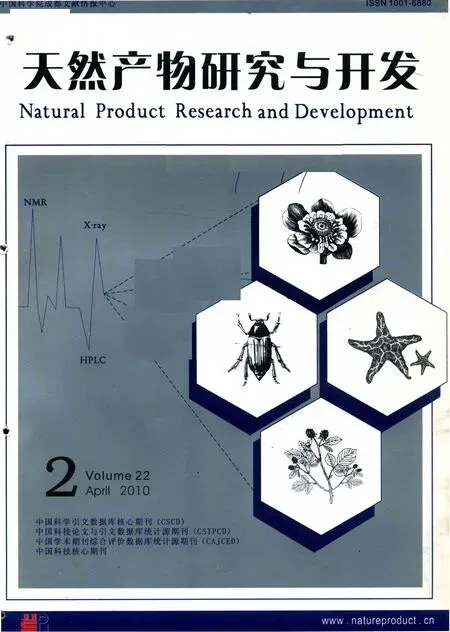长筒石蒜鳞茎中的生物碱类成分
梁永奇,冯 煦,赵兴增,陈 雨,董云发,王 鸣
江苏省中国科学院植物研究所江苏省药用植物研究开发中心,南京 210014
Introduction
As an important member of Amaryllidaceae,Lycoris longituba,is mainly distributed in Jiangsu province of China.Most plants ofAmaryllidaceae are known to produce structurally unique alkaloidswhich possessing interesting in physiological effects,including antitumour, acetylcholinesterase inhibitor,immunostimulatory and antimalarial activities.In search for bioactive constituents from thisplant,we phytochenically investigated the bulbs ofLycoris longitubacollected in Baohua mountain,Jiangsu province,which has not been studied previously.Up to date,seven alkaloidswere isolated and identified as galanthamine(1),lycoramine(2),6-hydroxycrinamine (3a and 3b),(-)-amarbellisine (4),tazettine(5)and macowine(6).Among them, compounds 3a-6 were obtained from this plant for the first time.
Exper imental
General
Nuclear magneticresonance (NMR) spectra were measured on Bruker AV-300、AV-500spectrometer with tetramethy-silane(T MS)as an internal standard. Melting points were determined on a Boetiusmic melting point apparatus(uncorrected).Column chromatographywas performted with Silica gel(200-300 mesh) Qingdao Marine Chemical Co.Ltd,China.Sephadex LH-20 Amersham Biosciences Inc,USA,,ODS Y MC Co.Ltd,Japan and D101 macroporous resin Tianjin Haiguang Chemical Co.Ltd,China respectely.All other chemical reagents used in this study were of analytical grade.
Plantmater ial
The whole plant ofLycoris longitubaY.Hsu et Q.J. Fan was collected inMarch 2008 in Baohua mountain, Jiangsu province of China,and identified by Professor Yuan Chang-qi,A voucher specimen is deposited in the Herbarium of Institute of Botany,Jiangsu Province and Chinese Academy of Sciences.
Extraction and isolation
The fresh bulbs ofLycoris longituba(41 kg)were cut into pieces and exhaustively extracted with hot ethanol (60 kg)for 3 times(2 hours each t ime).After removal of ethanol,the water suspension was extracted with petroleum ether,the remainderwas filtered using filterpaper.The aqueous solution was passed through D101 macroporous resin and eluted with water,70%EtOH and 95%ethanol.The 70% ethanol fraction(75 g) was chromatographed on silica gel columns using a gradient ofCHCl3∶MeOH∶H2O(10∶1∶0.1→17∶3∶0.2→4∶1∶0.1→7∶3∶0.5)to give 8 fractions(A-H).The fraction A(15 g)was repeatedly chromatographed on silica gel columns using CHCl3∶MeOH∶H2O(10∶1∶0.1)solvent system to give compounds 1(148 mg), compounds 2(195 mg)and compounds 3a and 3b (700 mg).The fraction B(8 g)was repeatedly chromatographed on silica gel columns using CHCl3: MeOH:H2O(17∶3∶0.2)solvent system to give compounds 4(498 mg),compounds 5(50 mg)and compounds 6(752 mg).All those compoundswere further purified by ODS and Sephadex LH-20 columns using anMeOH-H2O solvent system.
Result and Conclusion
Compound 1 White powder,potassium bis muth iodide reagent showed orange.1H NMR (CD3OD,300 MHz)δ:2.14(1H,m,H-1α),1.67(1H,m,H-1β),4.15(1H,t,J=5.0 Hz,H-2),5.92(1H,dd,J =10.3,4.8 Hz,H-3),6.13(1H,d,J=10.3 Hz,H-4),2.49(1H,m,H-6α),2.07(1H,m,H-6β),3.22 (1H,dd,J=14.3,1.7 Hz,H-7α),3.02(1H,dt,J= 14.3,3.0 Hz,H-7β),4.09(1H,d,J=14.9 Hz,H-9α),3.67(1H,d,J=14.9 Hz,H-9β),6.74(1H,d, J=8.2 Hz,H-11),6.64(1H,d,J=8.2 Hz,H-12), 4.55(1H,dd,J=3.1,2.0 Hz,H-16),2.38(3H,s,-NCH3),3.69(3H,s,-OCH3).13C NMR(CD3OD,75 MHz),δ:31.59(C-1),62.62(C-2),128.58(C-3),128.43 (C-4),49.23 (C-5),35.70 (C-6), 55.16(C-7),61.49(C-9),129.63(C-10),123.06 (C-11),113.28(C-12),147.80(C-13),145.60 (C-14),89.15(C-16),43.02(7-NCH3),55.16(-OCH3).Compound 1 was identified as galanthamine by comparison of the physical and chemical properties and spectral data with the literature[1].
Compound 2 White powder,potassium bis muth iodide reagent showed orange.1H NMR (C5D5N,500 MHz)δ:1.54-1.74(7H,m,H-1,3,4β,6),2.54 (1H,dt,J=15.7,2.7 Hz,H-4α)4.24(1H,m,H-2),3.16(1H,d,J=14.3 Hz,H-7α),2.93(1H,d, J=14.3 Hz,H-7β),4.05(1H,d,J=14.9 Hz,H-9α),3.64(1H,d,J=14.9 Hz,H-9β),6.72(1H,d, J=8.1 Hz,H-11),6.63(1H,d,J=8.1 Hz,H-12), 4.34(1H,t,J=3.4 Hz,H-16),2.3 (3H,s,-NCH3),3.71(3H,s,-OCH3).13C NMR(C5D5N,125 MHz),δ:33.05(C-1),64.59(C-2),28.04(C-3), 24.62(C-4),47.39(C-5),32.00(C-6),54.28(C-7),56.04(C-9),130.31(C-10),121.46(C-11), 111.95(C-12),147.55(C-13),144.48(C-14), 89.81(C-16),41.08(7-NCH3),60.59(-OCH3). Compound 2 was identified as lycoramine by comparison of the physical and chemical properties and spectral data with the literature[1].
Compound 3a and 3b recrystallized as colorless square crystal(CH3OH)was homogeneous chromatographically but the signals in both1H NMR and13C NMR spectra were rather complex,suggesting that it was 3a∶1 mixture of two epimers in the C-6 position,mp.151-153℃,potassium bis muth iodide reagent showed orange,the spectral data of 3a and 3b are as follow:
Compound 3a EI-MSm/z:317[M]+;1H NMR (CD3OD,500 MHz)δ:6.45(1H,d,J=10.1 Hz,H-1),6.24(1H,dd,J=10.1,5.1 Hz,H-2),3.88 (1H,m,H-3),2.13(1H,dt,J=14.1,4.3 Hz,H-4α),1.93(1H,dt,J=14.1,4.3 Hz,H-4β),3.62 (1H,dd,J=9.0,4.4 Hz,H-4a),4.92(1H,s,H-6), 6.88(1H,s,H-7),6.77(1H,s,H-10),3.85(1H, m,H-11),3.07(1H,dd,J=14.1,3.5 Hz,H-12 exo),3.35(1H,dd,J=14.1,6.6 Hz,H-12 endo), 5.90(2H,dd,J=2.8,1.2 Hz,O-CH2-O),3.35 (3H,s,-OCH3).13C NMR(CD3OD,125 MHz),δ: 130.90(C-1),129.22(C-2),74.46(C-3),28.64 (C-4),59.29(C-4a),89.25(C-6),129.42(C-6a),110.34(C-7),147.70(C-8),149.30(C-9), 103.77(C-10),138.42(C-10a),51.54(C-10b), 56.63(-OCH3),102.43(O-CH2-O).Compound 3a was identified as 6β-hydroxycrinamine by comparison of the physical and chemical properties and spectral data with the literature[2].
Compound 3b EI-MSm/z:317[M]+;1H NMR (CD3OD,500 MHz)δ:6.44(1H,d,J=10.1 Hz,H-1),6.24(1H,dd,J=10.1,5.1 Hz,H-2),4.01 (1H,m,H-3),2.27(1H,dt,J=13.5,4.3 Hz,H-4α),1.93(1H,dt,J=13.5,4.6 Hz,H-4β),3.77 (1H,m,H-4a),5.46(1H,s,H-6),6.86(1H,s,H-7),6.87(1H,s,H-10),3.86(1H,m,H-11),2.76 (1H,dd,J=14.9 Hz,3.03 Hz H-12 exo),3.36 (1H,dd,J=14.9,8.0 Hz,H-12 endo),5.90(2H, dd,J=2.9,1.2 Hz,O-CH2-O),3.34(3H,s,-OCH3) .13C NMR(CD3OD,125 MHz),δ:130.72(C-1), 129.42(C-2),74.26(C-3),29.01(C-4),63.52 (C-4a),86.98(C-6),129.48(C-6a),109.11(C-7),147.90(C-8),149.15(C-9),103.77(C-10), 137.57(C-10a),51.02(C-10b),56.73(-OCH3), 102.43(O-CH2-O).Compound 3b was identified as 6α-hydroxycrinamine by comparison of the physical and chemical properties and spectral data with the literature[2].
Compound 4 White powder.potassium bis muth iodide reagent showed orange.EI-MSm/z:301[M]+;1H NMR(CD3OD,500 MHz)δ:3.46(1H,m,H-1), 5.57(1H,s,H-3),3.36(1H,d,J=1.9 Hz,H-3a), 2.11(1H,m,H-4α),1.44(1H,dt,J=12.3,3.0 Hz,H-4β),3.05(1H,d,J=11.1 Hz,H-5exo),3.00 (1H,dd,J=11.1,2.0 Hz,H-5endo),4.30(1H,d,J =16.5 Hz,H-7α),3.80(1H,d,J=16.5 Hz,H-7β),6.52(1H,s,H-8),6.59(1H,s,H-11),5.85 (2H,dd,J=0.9,0.9 Hz,O-CH2-O),3.42(3H,S,-OCH3).13C NMR(CD3OD,125 MHz),δ:80.24(C-1),154.64(C-2),114.23(C-3),59.52(C-3a), 32.77(C-4),56.13(C-5),61.46(C-7),133.57 (C-7a),108.27(C-8),147.67(C-9),148.36(C-10),107.76(C-11),125.19(C-11a),46.72(C-11b),102.11 (O-CH2-O),57.70 (-OCH3) .Compound 4 was identified as(–)-amarbellisine by comparison of the physical and chemical properties and spectral data with the literature[3].
Compound 5 Colorless square crystal(CH3OH), potassium bis muth iodide reagent showed orange.mp 209-211,EI-MSm/z:331[M]+;1H NMR(CD3OD, 500 MHz)δ:6.29(1H,d,J=10.4 Hz,H-1),6.11 (1H,dd,J=10.4 Hz,3.23 Hz,H-2),4.37(1H,m, H-3),2.34(1H,m,H-4α),1.80(1H,m,H-4β), 3.06(1H,t,J=1.7 Hz,H-4a),3.70(1H,d,J= 10.4 Hz,H-6α),2.96(1H,d,J=10.4 Hz,H-6β), 5.30(1H,d,J=14.6 Hz,H-8α),4.78(1H,d,J= 14.6 Hz,H-8β),6.63(1H,s,H-9),7.15(1H,s,H-12),5.93(2H,dd,J=11.6,1.2 Hz,O-CH2-O), 3.40(3H,s,-OCH3),2.46(3H,s,-NCH3).13C NMR(CD3OD,125 MHz),δ:130.14(C-1),130.81 (C-2),73.82(C-3),27.13(C-4),70.39(C-4a), 66.28(C-6),102.30(C-6a),62.03(C-8),127.15 (C-8a),104.52(C-9),146.77(C-10),146.79(C-11),109.85(C-12),129.27(C-12a),50.85(C-12b),102.43(O-CH2-O),55.82(-OCH3),42.39(-NCH3).Compound 5 was identified as tazettine by comparison of the physical and chemical properties and spectral data with the literature[4].
Compound 6 White powder.potassium bis muth iodide reagent showed orange.EI-MSm/z:273[M]+;1H NMR(CD3OD,300 MHz)δ:6.71(1H,d,J=10.0 Hz,H-1),5.82(1H,dd,J=10.0,5.2 Hz,H-2), 4.27(1H,m,H-3),1.94(1H,m,H-4α),1.77 (1H,dt,J=13.3,4.2 Hz,H-4β),3.38(1H,m,H-4a),4.35(1H,d,J=16.5 H-6α),3.79(1H,d,J= 16.5,H-6β),6.51(1H,s,H-7),6.94(1H,s,H-10),1.89(1H,m,H-11exo),2.16(1H,m,H-11endo),3.42(1H,dd,J=13.1,4.5 Hz,H-12 exo),2.92 (1H,m,H-12 endo),3.84 (3H,s,-OCH3).13C NMR(CD3OD,75 MHz),δ:132.55(C-1),128.40 (C-2),64.51 (C-3),33.47 (C-4), 64.19(C-4a),62.43(C-6),125.71(C-6a),114.71 (C-7),146.16(C-8),147.67(C-9),107.40(C-10),137.40(C-10a),45.36(C-10b),56.67(-OCH3).Compound 6 was identified as macowine by comparison of the physical and chemical properties and spectral data with the literature[5].
Acknowledgement We thank the Rural Depar tment Project of Nanjing Science and Technology Burear (No:200701056)for financial support.
1 Yang Y(杨郁).Studies on the chemical constituents and biological activities ofLycoris aureaand bidens pilosa.Beijing: Academy ofMilitaryMedical Sciences(军事医学科学院), M.2005.
2 Francesc V,Giovanna R,A lmanza,et al.Alkaloids from B runsvigia orientalis.Phytochem istry,1996,43:1379-1384.
3 Antonio E,Anna A,Amina H,et al.(–)-Amarbellisine,a lycorine-type alkaloid fromAm aryllis belladonnaL.growing in Egypt.Phytochem istry,2004,65:2113-2118.
4 Lam HP,Egon G,JürgenW,et al.Two novelAmaryllidaceae alkaloids fromHippeastrum equestreHerb.:3-O-demethyltazettine and egonine.Phytochem istry,1999,51:327-332.
5 Nair JJ,Machocho AK,CampbellWE,et al.Alkaloids from Crinum m acowanii.Phytochem istry,2000,54:945-950.
- 天然产物研究与开发的其它文章
- 蒙桑叶化学成分研究
- 暖地大叶藓化学成分的研究

